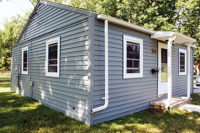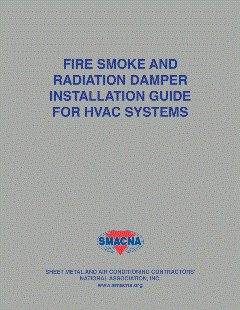When people step inside their homes, they tend to feel safe and protected from the outdoor world — and completely unaware of the many sources of pollution affecting their indoor environments.
“According to the EPA [Environment Protection Agency], the air within our homes can be up to 100 times more polluted than outdoor pollutant levels,” said Aaron Engel, vice president, marketing, Sanuvox Technologies Inc. “Headache, congestion, problems concentrating and sleeping, and asthma symptoms are among the many common issues than can affect homeowners and occupants.”
According to IAQ product experts, contractors need to educate customers about the sources of indoor pollution.
“It’s important to inform the homeowner that air quality is not something to be taken lightly and the proper system can improve both the home’s overall health and the occupants’ comfort level dramatically,” said Kent Kuffner, indoor air quality product manager, Carrier Corp.
Health Effects
“Poor IAQ can really affect people’s well-being,” said Carl Redner, president, General Filters Inc. “Eye, nose, and throat irritation are usually short term, but can also be an indication of a real problem if they persist. Headaches, dizziness, and fatigue can also result. Over time, this exposure can lead to more serious health concerns such as respiratory disease, cardiovascular disease, or even cancer.”
Those who suffer from allergies and asthma are often the most likely to pay attention to the quality of air in their home.
According to Kevin Sulzer, marketing manager, Koch Filter Corp., “In the residential market, it is the effects of air quality on allergies that homeowners notice.”
Redner added, “With one in 11 people in the U.S. suffering from asthma, every fourth or sixth house has an occupant who is very aware of air quality. Their symptoms can be worsened by allergens or irritants they inhale. These folks would like to have something that reduces doctor office visits, emergency room visits, and hospitalizations.”
Tony Fedel, P.E., associate marketing director, Kimberly-Clark Professional Filtration, noted that the symptoms “may be more acute in the very young, the very old, and those with underlying health issues.”
Moreover, Redner said, “While allergy and asthma sufferers tend to feel the effects of poor IAQ a bit more than others, it doesn’t mean that others in the home aren’t adversely affected as well. Even people experiencing no obvious symptoms can be adversely affected over time.”
Inside Sources
According to Fred Perfetto, vice president, commercial and consumer IAQ products, RGF Environmental Group, “There are many common problems that are a result from a polluted indoor air environment which really have just a few sources. These sources are microbial, gases, and particulates.”
“Gases include VOCs [volatile organic compounds] and odors,” he said, adding that particulates are small particles suspended in the air. “Samples of these are dander, dust, and pollen. Common residential sources of these include smoke, adhesives, cleaning agents, new furniture and rugs, and pet and food odors.”
While new furniture may be releasing VOCs and odors into the home, older furniture can also be a source of pollution.
“Older furnishings and carpets can contain significant deposits of pollen, spores, and animal dander, as well as dust from the deterioration of synthetic materials. These can be lofted into the air by the activity of people,” Redner said.
Kuffner elaborated on the harmful effects of particulate pollution.
“Particles like these are lightweight and can stay suspended in mid-air unless properly removed, and those smaller particles are sometimes the ones that cause the most adverse health effects,” he said. “Although the human body’s immune system can deal with a certain level of contaminants, once allergens or other airborne pollutants reach a threshold, adverse health effects and allergic reactions will occur.”
Summing up the sources of harmful indoor pollution in another way, Ken Nelson, Northwest regional sales manager, Panasonic Eco Solutions, classified them as falling into three principle themes: “materials outgassing (formaldehyde), moisture-related bacteria (mold and mildew), and occupant-created contaminants (smoking, cooking, pets, cultural habits, etc.).”
Patrick Nielsen, marketing manager, ventilation fans, Broan-NuTone LLC, noted that humidity is often the biggest problem.
“It can cause mold, which can negatively impact some people’s health and comfort. Humidity is usually related to spot ventilation, as it is often generated by showers or cooking, which occur at a particular place and time,” he said.
Brian Wellnitz, marketing manager, kitchen ventilation, Broan-NuTone LLC, further detailed how cooking can affect home IAQ.
“Cooking is a major source of a broad array of pollutants, including grease vapors and humidity — leading contributors to the development of mold. As a result, consumers may see breathing disorders aggravated as well as lingering cooking odors,” he said.
Tighter Construction
Yet it’s not just sources inside the home that affect IAQ — the way the home was constructed also impacts the air quality.
“Because homes are built more tightly with less air infiltration through leakage, odors, and other pollutants such as particulates, combustion byproducts, and VOCs from off-gassing building materials or cleaning chemicals are trapped inside the home,” Nielsen said.
Lane Jeffryes, CEO and president, Rotobrush Intl. LLC, explained the reasons behind the trend toward tighter construction.
“New homes are now built tighter due to more energy-efficient building codes, and a certain percentage of existing homes have been weatherized,” he said. “These types of homes are more likely to trap indoor contaminants as they don’t ‘breathe’ as they should, meaning enough outdoor air isn’t being brought in to dilute contaminants or carry them out of the home.”
Healthy Solutions
Although the source of indoor pollution can seem endless, the good news is that there is a wide array of solutions available for the residential market. And these solutions run the gamut from low- to high-tech options.
Before contractors dazzle homeowners with high-tech products, Nelson strongly urged them to consider basic source management.
“Source management simply means, before spending any money on any device that claims to improve air quality in a home, you first look around and see what may be causing the problem, then remove it,” he said.
Although, he acknowledged, this isn’t always as simple as it sounds.
For example, Nelson said, “Recently I was called to a home where the children were having asthma issues, specifically related to cat dander. … When I asked whether they own a cat, the answer was yes, but they keep it ‘in the back of the house.’ Now, I certainly didn’t want to tell these fine people that their beloved kitty needs to go. But if the kids are to get relief from the cat dander, the simplest and lowest-cost solution should be obvious.”
He continued, “Beyond that, we start increasing ventilation/air changes, adding air filtration, and changing carpets to hardwood/tile flooring. And still they would have the cat and its associated airborne dander.”
Stressing the importance of air filtration is another primary step in the process to improve a home’s IAQ.
According to Sulzer, “In most cases, homeowners go the least expensive route when selecting an air filter. They do not take into consideration or understand the differences between the air filters available in the retail outlets. As a result, they do not receive the benefits of increased life in their filter as well as the ability to filter those particulates causing their allergies.”
Plus, he added, “In some cases the filters may only be changed once or twice a year, allowing the filters to become less efficient and their system to work harder. I think it is important that contractors stress that filters get changed out monthly. Not only will it improve air quality, but it will also extend the life of the consumer’s unit.”
Fedel also stressed the importance of air filters.
“Contractors should recommend a robust air filtration program, which includes using an air filter in their home heating system that provides excellent capture of submicron particles, which are the tiniest airborne particles that can travel deeply into the lungs where they can cause health problems,” he said. He recommended changing out air filters about every three months or as directed by the filter manufacturer.
However, he noted, “Homeowners may want to consider more frequent change outs if they are doing remodeling work in the home, which can generate additional dust and airborne particles, or if someone in the home has asthma or severe allergies.”
“The key technologies we focus on are particle removal via air filtration, humidity control, and ventilation,” Kuffner said. “Solutions we make available to our customers in order to address these issues include air purifiers, ventilators, and humidifiers.”
As an example, he noted the Carrier® Infinity® air purifier.
“[It] features a long-life MERV 15 filter and patented Captures and Kills™ technology that captures up to 95 percent of particles 0.3 to 1.0 microns in size; killing or inactivating up to 99 percent of germs, pollen, and mold captured. With every cycle of air that passes through this patented air purifying system, pollen, animal dander, bacteria, and other pollutants are trapped and held tightly to the filter. An electrical charge then bursts the cell walls of the pathogens.”
When it comes to ventilation, Nielsen noted that there are energy-efficient options on the market for both spot and whole-house approaches.
“Many of the new models on the market such as the Broan® and NuTone® ULTRA™ Series ventilation fans offer multispeed capabilities such that they can run continuously at lower levels and then increase their output for showers. They also come with humidity- or motion-sensing capability to make operation a breeze,” he said.
Nielsen continued, “Heat or energy recovery ventilators (HRVs and ERVs) are balanced ventilation solutions which exchange stale indoor air for fresh outdoor air at the same air movement rates while saving energy and thus reducing heating and cooling bills.”
Wellnitz offered a practical solution for IAQ problems caused by cooking: “Install Home Ventilating Institute (HVI)-rated range hoods that are ducted to the outdoors and make sure that there is adequate make-up air using an interlocked make-up air damper.”
In order to aid contractors in identifying IAQ issues in a home, Jeffryes said that Rotobrush partners with AirAdvice for Homes to offer its IAQ home monitoring system to contractors.
“Contractors place the monitor in a home, where it continually measures and transmits data for a week concerning six areas of air quality (temperature, humidity, carbon monoxide, carbon dioxide, particulates, and VOCs) to the AirAdvice for Homes data center,” he said. “Contractors log into the company’s website to generate comprehensive reports from the data gathered, diagnosing IAQ issues and providing solutions. They can then share these reports and solutions with the homeowner as part of their IAQ services.”
Redner expanded the list of solutions contractors can provide.
“You can control your indoor air with products like whole-house air cleaners, humidifiers (or dehumidifiers), UV-light air purifiers, photo-catalytic air purifiers, and ventilation systems,” he said. “UV light purification was first used to treat water, but is now used in residential homes to remove harmful germs, bacteria, viruses, mold, and mildew. When a photocatalytic air purifier is installed, VOCs, hydrocarbons, and solvents can be removed from the air. Photocatalytic technology has been a significant advancement for IAQ.”
Engel emphasized how effective UV air treatment systems can be.
“Incorporating a UV air treatment system into the ductwork will address the biochemical contaminants that are circulating through the HVAC system and building in concentration within the home’s envelope,” he said.
According to Forrest Fencl, president, UV Resources, “If the air is conditioned, the most common problems are mold and Gram-negative bacteria growth on the coil and in the drain pan. Many find that the simple addition of UV on the downstream side of the coil solves these particular issues and provides cleaner, healthier air by preventing microbial buildup.”
He added that to make the case for this product, “Successful contractors have used before-and-after pictures of the downstream side of the coil plenum along with the coil and drain pan.”
Perfetto pointed out two of RGF’s solutions for homeowners.
“The Guardian Phi Cell will reduce gases and microbial pollution up to 99 percent. The Reme system treats everything that the Guardian unit does, plus it addresses the particulates by clumping the particles in the air to increase the efficiency of the filter. Both systems produce proactive ionized hydroperoxcides that aggressively seek out and oxidize contaminants,” he said.
With all of the solutions available, smart HVAC contractors must be ready to step up and address IAQ options with homeowners.
“Knowing what is wrong with their home’s IAQ and the consequences to their family’s health will spur the majority of homeowners into action, as long as a contractor is confident, knowledgeable, and takes the time to help them understand,” Jeffryes said.
Publication date: 7/15/2013
Want more HVAC industry news and information? Join The NEWS on Facebook, Twitter, and LinkedIn today!
















